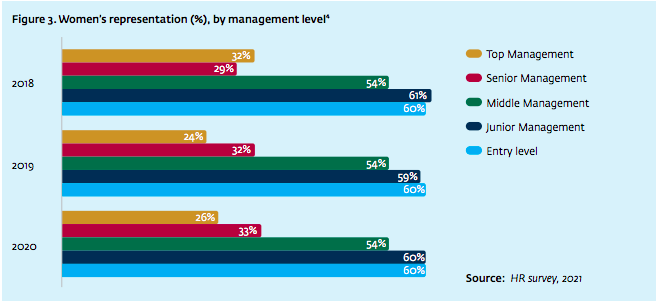More female leaders needed in Vietnam’s banking sector: IFC
Gender-diverse leadership teams offer significant benefits to banks, from the strength of leadership teams, and cultural diversity, to viable financial performance metrics.
While women make up 60% of entry-level employees in Vietnam's banks, less than one-third make it to senior and top management positions, according to a new study by IFC in partnership with the State Bank of Vietnam.
| Women’s representation in management correlates to better financial returns. Photo: Vietcombank |
The study, "Mind the gap: Getting more women into leadership in Vietnam's banking sector," shows that there is a strong recognition of the value of gender equality in the banking sector, particularly how gender diversity in leadership positions can help banks attract and retain skilled talent while building a robust base of female leadership talent, increasing workforce productivity and financial performance.
However, many banks did not know how or were not making the effort to create a more gender-balanced workforce and leadership team. Women reported less access to all forms of training and career development opportunities, with strong evidence that they also faced overt and unconscious bias around childbearing and childcare responsibilities.
"In our branches, most of our Head of Branch Service [equivalent to Deputy Branch Director] are women, accounting for about 95% of the bank-wide headcount for this position. However, for the position of branch manager, the number has dropped drastically as women seem to be less well prepared for the role," said a female board member of a large commercial bank.
While gender is not a factor in effective leadership, Nguyen Thi Hong, Governor of the State Bank of Vietnam, suggested that gender-diverse leadership teams offer significant benefits to banks, from the strength of leadership teams and cultural diversity to viable financial performance metrics.
"Increasing the representation of women in the banking workforce is essential, especially as banks in Vietnam face challenges in recruiting and retaining talent to remain competitive in the market," Hong said.
| Gender balance by numbers. |
Gender-diverse leadership is good for business
The Governor’s view was backed up by studies that show women’s representation in management correlates to better financial returns.
IFC’s study ‘Board Gender Diversity in ASEAN’2 conducted across six ASEAN countries – including Vietnam – found that companies with more than 30% female board membership were associated with greater financial performance, compared to companies with no women on their boards and firms where women accounted for less than 30% of board membership. Companies without women board members, earned an average Return on Assets (ROA) of 2.4%, whereas, companies where women accounted for more than 30% of board membership, had an average ROA of 3.8%.
"At our bank, women are well-qualified, innovative thinkers who make a positive contribution to the bank's operations. Consequently, more women in leadership positions mean better utilization of our human capital and better employee engagement. When employees, especially women, see that their contributions are recognized, they find the motivation to increase work efficiency, drive innovation, and more," said a top executive at a large commercial bank.
The Covid-19 pandemic has also brought to light the undeniable value of women’s leadership. The Harvard Business Review reported that women business leaders were rated more positively during the health crisis. Women leaders scored higher on crisis management leadership skills —including concern for employees’ wellbeing, ability to inspire and motivate, integrity, agility, decisiveness, collaboration, and innovation.
“With a flexible, skillful but decisive nature, female leaders in our bank in recent years have been able to handle jobs and relationships in a very flexible and effective way, contributing to the growth of the bank,” said an HR manager at a major commercial bank.
The argument for gender diversity in leadership goes beyond financial returns alone. More women in C-suites and boards lead to greater shareholder value, reduced risk of fraud and corruption, increased customer and employee satisfaction, greater investor confidence, and enhanced market knowledge and reputation. An increasing global body of research further supports many business benefits associated with gender diversity on company boards and senior leadership.
| Gender-balanced leadership leads to better financial returns and other benefits for employees, investors, and businesses. Source: HD Bank |
More support required
The study also found that while 80% of people felt safe at work, nearly one in five had witnessed bullying and one in ten had personally experienced bullying behavior, with similar responses among men and women.
Based on surveys of nearly 40,000 bank employees and interviews with senior and middle managers, the study also found that women want better support for work-life balance.
A female middle manager at SBV called for more opportunities for women to contribute and be promoted, and to be fairly recognized for their performance.
"It is important to remove the barrier to women's career advancement, which is the belief that having children makes women less committed to work and progression," she noted.
Another female mid-level manager in a commercial bank, aged 25 to 34, suggested that women may find leadership positions more challenging than men "because women have to focus not only on their careers but also on taking care of their families.
"If the bank allows women to work flexible hours and locations, women can balance work and family responsibilities and therefore contribute more to the bank," she said.
“Lack of gender diversity in leadership in the banking sector is a persistent problem globally,” said Thomas Jacobs, IFC Country Manager for Vietnam, Cambodia, and Laos. “While Vietnam is doing better than some other countries in terms of women in bank management, this report clearly shows more should be done to turn commitments into practical steps enabling women to move into leadership positions. We know that gender-balanced leadership leads to better financial returns and other benefits for employees, investors, and business.”
On December 31, 2021, the SBV issued the Master Plan to implement the National Strategy on Gender Equality in the Banking Sector in 2021-2030. The plan aims to close gender gaps and create equal opportunities for all employees in Vietnam's banking sector, thereby contributing positively and effectively to the sustainable development of the banking sector and the implementation of the National Strategy on Gender Equality.
"Our plan to implement the National Strategy for Gender Equality in 2021-2030 has just begun. However, if we work together, we will make positive and meaningful changes, close the gender gap, create equal opportunities, promote gender diversity, and have more women in leadership positions in Vietnam's banking sector," said SBV Governor Nguyen Thi Hong.












